
Michael Gerhardt argues that the presidency is designed to stretch the boundaries of its power.
Presidents often face criticism for “executive overreach.” But many of America’s most revered presidents solved problems by expanding the scope of their powers. And when one president expands his authority, the office of the president usually keeps that authority, causing an evolution toward expanded presidential power.
Speaking during the opening session of the University of Pennsylvania Law Review’s 2015 Symposium, Professor Michael Gerhardt of the University of North Carolina Law School and the National Constitution Center explained that the president’s tendency to be “constitutionally arrogant” causes this phenomenon. He argued that the presidency, as an institution, is “peculiarly designed” to stretch the boundaries of its power.
Moderator Jean Galbraith, a law professor at the University of Pennsylvania Law School, began the session with a quote from former Supreme Court Justice Robert H. Jackson: “If not good law, there was a worldly wisdom in the maxim attributed to Napoleon that ‘the tools belong to the man who can use them.’” The theme of executive discretion reverberated throughout the session.
Constitutional arrogance, said Gerhardt, is not a reflection of presidential personalities, but is the product of structural, political, social, and historical forces shaping the office. He did not question the motives behind boundary-pushing presidential actions, but noted that these actions do not always succeed, often provoke even stronger push-back from other institutions, and may constitute abuses of power, even if motivated by good intentions.
Gerhardt stressed three factors that push presidents institutionally toward constitutional arrogance.
First, he argued that the presidency is designed to be efficient and energetic. Even when Congress is gridlocked, people expect the president to act. Its hierarchical structure works to achieve positive, unilateral action. This disposition is reinforced through the organizational dynamic of the executive branch, which tends to reward those (most) loyal to the president and punish dissenters. Gerhardt noted, for example, that after most of President John Tyler’s cabinet resigned to protest his exercise of executive power, he reconstituted his cabinet to comport with – and reinforce – his constitutional vision. Rather than weaken Tyler, the resignations provided him the opportunity to consolidate his control over the cabinet and administration.
Second, Gerhardt argued that historical practices support the disposition toward constitutional arrogance. History rewards presidents who take action. And action often requires expanding power, which future presidents may reinforce and support. Constitutional arrogance may thus signal an effort to construct a new or expanded understanding of presidential power, which other presidents may choose to follow or to reject.
The third factor is constitutional indeterminacy. Through unilateral actions, presidents may seek to exploit constitutional ambiguities or silence.
Of several constraints on presidential discretion, including the Constitution, Gerhardt argued that popular support is the most important. But he noted that popular support only limits presidential action on matters that are visible to the public; indeed, much of what presidents do takes place outside of the limelight.
Gerhardt reinforced his point by referencing the recent dispute over the president’s recess appointment authority – that is, the president’s power to appoint heads of departments during legislative recesses, thereby bypassing the usual Senate confirmation requirement. Gerhardt noted that presidents have increasingly bypassed Congress by using their recess appointment power even when the Senate has recessed for only short periods of time. He explained that, while the Supreme Court overturned the recess appointments President Obama made during a short, three-day break in the Senate, it also upheld the more longstanding practice of presidents to make recess appointments during breaks as short as ten days. He argued that President Obama’s actions could best be understood within the larger arc of recess appointments over time.
Additionally, Gerhardt noted that President Barack Obama recently announced an immigration policy without congressional authorization, even though he previously acknowledged that he did not have such power. Necessity, said Gerhardt, was the only new condition. And because the president tends to “win that argument every time,” the action rendered other boundaries on presidential action meaningless, at least temporarily.
Gerhardt suggested that such unilateral action is not unusual, but rather very common in the modern era. Presidents are able to move much more quickly than Congress. This speed allows the president to occupy the space left unfilled as a result of Congress’s failure to enact laws that they would have favored. Such unilateral actions place the burden on other branches, as well as the American people, to resist.
Commenting on Gerhardt’s paper, Aziz Huq, a professor at the University of Chicago Law School, contended that these case studies might be examples of presidential obligation rather than unambiguous arrogance. For one, he said, recess appointments are often needed to staff agencies. He also argued that the immigration system requires broad executive discretion because Congress provides funding for the president to deport only a fraction of those eligible.
This essay is part of The Regulatory Review’s ten-part series, The Bounds of Executive Discretion in the Regulatory State.
The recent Symposium was co-sponsored by the Penn Program on Regulation (PPR) and organized by Penn Law professors Cary Coglianese, director of PPR, and Christopher Yoo.



